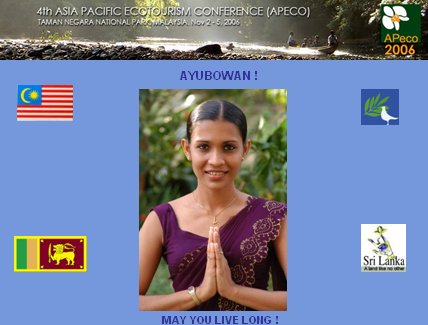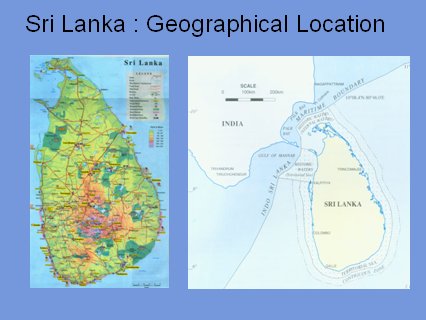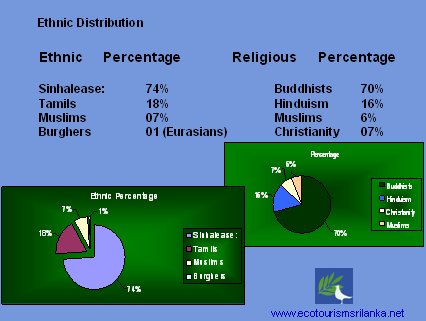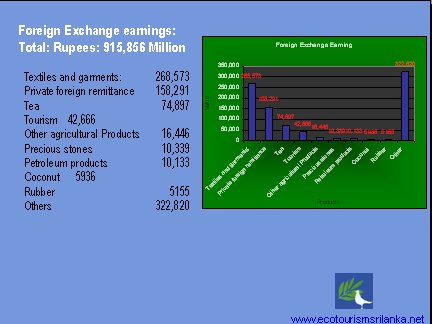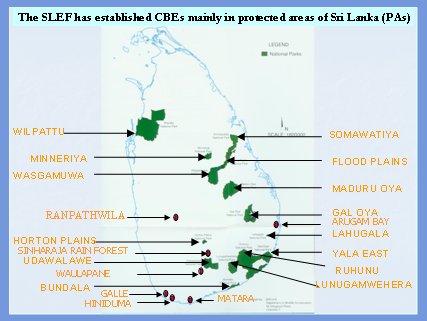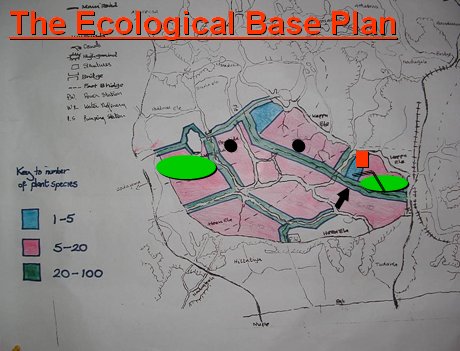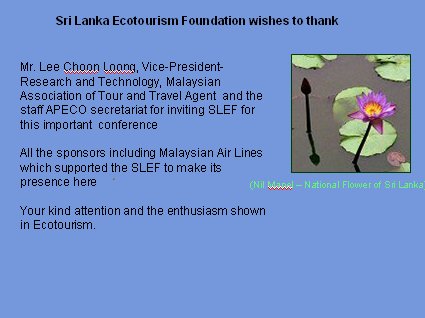|
|
||
|
Who are We? (SLEF) The Sri Lanka Ecotourism Foundation (SLEF) is the pioneer "Ecotourism Organisation" in Sri Lanka, and was established in 1998. It is registered as a non-profit NGO at the Central Environmental Authority (CEA) of Sri Lanka.
Mission Statement - To identify, develop and conserve ecological sites and locations in Sri Lanka; - To attract and direct ecotourists to selected sites in their pristine natural beauty; - To facilitate quality services for the ecotourists, such as interpretation, and interaction with the local communities or with conservation experts; - To empower local communities to participate in ecotourism projects, and to reap the economic benefits from them; - To participate in the formulation and development of a national ecotourism policy.
Sri Lanka means: “Fortunate Island” Other names for Sri Lanka: ‘Pearl of the Indian Ocean’, ‘Thambapanni’, ‘Taprobane”, ‘Serendib’, ‘Seylan’, ‘Ceylon’ Extant: 65610 SQ.KM Population: 19.8 (almost 20 million as per 2002 census) Population density: 311 Per Sq.Km
Location: Island off the south-eastern shores of India 5-55 and 9-50 degrees north of the equator in the India Ocean International Airport: Bandaranayike International Airport locate 35 kms from Colombo, close to Negombo
Domestic airports; Ratmalana (main),
Anuradhapura, Trincomalee, Sigiriya, Polonnaruwa, Batticola,
Weerawila, Koggala, Jaffna Community Based Ecotourism Projects Focus: - Ecotourism should use as a tool to alleviate poverty in the tourism generating areas - To strengthen the institutional capacity of the community and in the process to motivate the local communities to be involved in the complete tourism development process, from the planning stage to the implementation and management, through avenue of consultation and partnership - To assure economic justification to the community living around .the nature and adventure sites through ecotourism activities - To support in preserving and developing social and cultural .values .of the area through ecotourism. - To make aware and motivate the community in the area to preserve the natural resources and the biodiversity in appreciation of the economic returns the community receive through ecotourism operations
Why Community Based Ecotourism projects are important in Ecotourism? - CBEs are the most important entity within any ecotourism product or …an experience. - The concept of Community Based Ecotourism brings valuable ....meaning to the principles of ecotourism, without which the term itself ....can just be, a buzzword. - The true meaning of ecotourism can be found if it only incorporates …the concepts of Community Based Ecotourism in to the product
- Community Based Ecotourism
Enterprises (CBEs) are the base to develop genuine ecotourism fabric
in a country. Because, poor communities often see ecotourism as one
of the few livelihoods open to them. Communities, whose members are
living in poverty, invariably find their young people migrate to
urban centres because of the decline in traditional industries such
as agriculture and fishing. Ecotourism can prevent this urban drift
and provide an essential alternative income. Sharing Sri Lanka experience
Sri Lanka: as an example to explain you
what sort of ‘Challenges’ we have confronted during past 08 years.
Hope, our experience is very much common to most of the countries in
South Asia, East Asia and Pacific, and African continent. So, I
would like to share our experience in Sri Lanka of establishing and
running Community Based Ecotourism Projects
Sri Lanka’s protected and natural areas comprise 9700 SQ.KMS and account for 15% of the total land area. Within this area there are 192 villages, and 1.5 million people living, with poverty level in excess of 50% belong to the country’s poorest. Within this land area there are more than 70 (seventy) sanctuaries and national parks and number of wetlands and mountain ranges. The protected and natural areas of Sri Lanka are some of the most species-rich and endemic-rich ecosystems in Asia and are important catchments for major hydropower and irrigation systems
Challenges; Two fold When developing a Community Based Ecotourism Project: Planning Process of the Project Diverse views of the stake holders Explaining tourist benefits to the community Land use policies of the government/local government sectors Issues pertaining to scrotal coordination with other enforcement agencies (ex. Wildlife, archaeology, forests, environment etc) Political interferences Lack of knowledge in ecotourism/sustainable tourism amongst the officials
A case study: Kiralakelle Wetlands, Matara, Sri Lanka Obstacles from the bureaucrats as they have their own agendas with regard to finance/money They don’t like methodical step-by-step preparations such as Eco Plan- Click here
Similar case studies: Africa, Asia, Latin America
Community expects immediate financial benefits Try to cut down cost of tour package at the expense of providing low grade services to the visitors No transparency in spending money entrusted to them by the supporting organizations. Handling funds/difficult to trust/no proper book keeping Burden the visitors with personal requests/money etc Internal disputes/rivalries among the CBE/adjoining villages When the CBE gets tangible revenue from tourism what happens; A Case study; Ranpathwila Forest based Community ecotourism project, Sri Lanka
In Kampung Kuantan, Selangor State by
the Selangor River Extraordinary Phenomenon; Synchronized flashing
between trees inhabited by the fireflies. (Pteroptyx tener) They
have found only one species of mangrove, sonneratia caseolaris
Initially, the site is restricted to a limited number of biologists,
conservationists, amateur naturalists in the Kualampur area.
Gradually, a partnership formed between local conservation
organizations and the local boatmen of the village. Since the
mangrove bank were sensitive to erosion, villages agreed among
themselves not to use power boats instead traditional dug-out canoes
or non-motorized water crafts. Since there were rivalries among the
communities in adjoining villages with regard to sharing of tourist
income, they resorted to use the power boats. That’s the end of the
project - It is essential to conduct regular training and awareness programmes, review sessions, once the Community Based Ecotourism Project launched for the tourism business - Not to expect immediate financial benefits – Do your part will, first. No short-cuts to earn money through CBEs - Proper understanding about ‘Hospitality Skills’ and ‘providing quality services …to the visitors’ - Proper supervision and auditing needed when providing money ..and materials to the CBE - Regular auditing at least once in fortnight - Importance of TEAM WORK : No individual agendas when performing Community ..activities
Conclusion: Some Proposals - Formation of stake-holder associations of CBEs and explore Networking methods at regional level(for Asia Pacific Region) - Supporting community initiatives through soft loans (green loans etc) or grants on individual level - Support in capacity building/strengthening the institutional capacity/skill building of key-personal/develop interpretation skills of the communities of the community organization by training modules - Request all the governments in Asia-Pacific regions to contribute at least 0.5% from of TDL (Tourism Development Levy) to a Community Development Fund
Case Study: Kiralakelle Eco Plan Ecological Plan Info Needed for the Masterplan Needed to assess the current eco situation Needed to work on planting plans
To work towards a Master Plan Eco Plan Tourist Plan Enterprise Plan Community Plan Business Plan Land ownership plan Building plan
Innovative features of Kiralakelle (SLEF views) Located in the South of Sri Lanka at the fringes of Sri Lankas tropical rainforest and 60 Km from the Sinharaja Forest Reserve, a World Heritage Centre Built on partnerships with local communities, national businesses, National Government and international organisations Focused on identifying and utilising all nature values Committed to attaining financial self-sufficiency At the end of the Express highway and gateway to Matara A project by and for the community
Kiralakelle will identify all economical values in Nature Wildlife Ecotourism Ecosystem Services Traditional Knowledge Bio-Prospecting
Action SLEF is ready to advice, coordinate, communicate and have dialogues with partners to secure substantial sustainable action
|


